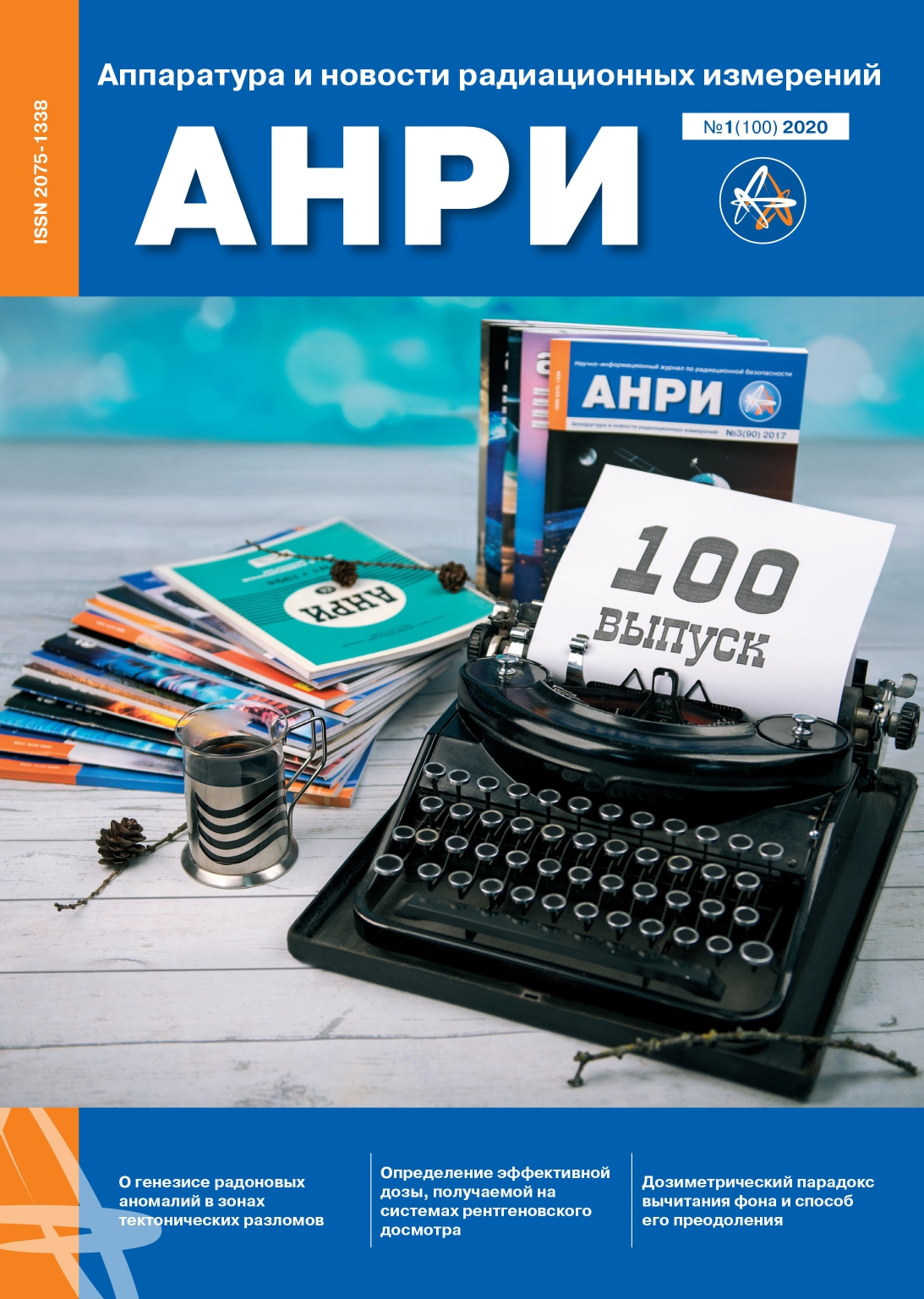Russian Federation
61
“The Law on Radiation Safety of the Population” and regulations for individual radiation-dosimetry monitoring suppose separate registration of background and technogenic exposure components. Background and technogenic radiation levels are comparable in the conditions of accident-free work of the personnel of group B and for the population. If their measurements are made by the same type of devices, there is a computational problem of background subtraction, which is usually solved by arithmetic methods, or even ignored. This leads to a known paradoxical bias of dosimetric information, allowing the existence of negative dose estimates or negative activities. The way allowing to overcome this paradox is considered in the publication.
radionuclides, radiation, dose, background, risk, individual, distribution, uncertainty, expected value, median, dispersion, randomness, protocol
1. Azizova T.V., Grigor'eva E.S., Hanter N. i dr. Risk smerti ot bolezney sistemy krovoobrascheniya v kogorte rabotnikov, podvergshihsya hronicheskomu oblucheniyu//Terapevticheskiy arhiv. 2017. № 1. S. 18-27.
2. GOST R 57216-2016. Radiacionnyy kontrol'. Predstavlenie rezul'tatov izmereniy. M: Standartinform. 2016, 24 c.
3. Determination of the characteristic limits for measurements of ionizing radiation - Fundamentals and application. International standard ISO 11929:2010(E). Geneva: ISO. 2010. 60 p.
4. Performance Criteria for Radiobioassay. An American National Standard ANSI/HPS no. 13.30-1996. USA: the Health Physics Society. 1996. 114 p.
5. L.A. Currie, «Limits for qualitative detection and quantitative determination», Anal. Chemistry, no. 40(3), pp. 586-593, 1968.
6. D. Stram et al., «Disaggregating measurement uncertainty from population variability and Bayesian treatment of uncensored results», Radiation Protection Dosimetry, vol. 149, no. 3, pp. 251-267, 2012.
7. G. Miller et al. «Bayesian prior probability distributions for internal dosimetry», Radiation Protection Dosimetry, vol. 94, no. 4, pp. 347-352, 2001.
8. Metodicheskie ukazaniya «Organizaciya i provedenie individual'nogo dozimetricheskogo kontrolya. Personal medicinskih organizaciy». MU 2.6.1.3015-12. Vvedeny v deystvie s 19.04.2012.
9. Metodicheskie ukazaniya. Dozimetricheskiy kontrol' vnutrennego professional'nogo oblucheniya. Obschie trebovaniya. MU 2.6.1.065-14. Vvedeny v deystvie s 01.01.2015.
10. Metodicheskie ukazaniya. Dozimetricheskiy kontrol' vneshnego professional'nogo oblucheniya. Obschie trebovaniya. MU 2.6.5.026-14. Vvedeny v deystvie s 18.05.2016.
11. Metodicheskie rekomendacii MR 2.6.1.0088-14. Forma federal'nogo statisticheskogo nablyudeniya №4-DOZ «Svedeniya o dozah oblucheniya naseleniya za schet estestvennogo i tehnogenno izmenennogo radiacionnogo fona». Utverzhdena prikazom Rosstata ot 16.10.2013, № 411.
12. Grigor'ev A.I., Pankratov L.V. Problemy vychitaniya fona pri individual'nom dozimetricheskom kontrole i radiacionnom kontrole na otkrytoy mestnosti//Radiacionnaya gigiena. 2011. T. 4. № 4. S. 42-48.
13. Grigor'ev A.I. K voprosu o vychitanii fona pri individual'nom dozimetricheskom kontrole//Radiacionnaya gigiena. 2013. T. 6. № 3. S. 53-55.
14. SanPiN 2.6.1.2523-09. Normy radiacionnoy bezopasnosti NRB-99/2009. 2009.
15. Federal'nyy zakon RF ot 09.01.1996 № 3-FZ. O radiacionnoy bezopasnosti naseleniya. V redakcii ot 19.07.2011 № 248-FZ. 2011.
16. Neopredelennost' izmereniya. Chast' 1. Mezhgosudarstvennyy standart GOST 34100.1-2017. M.: FGUP «STANDARTIMFORM», 2017. 21 s.
17. Fridlender G., Kennedi Dzh., Miller Dzh. Yadernaya himiya i radiohimiya. M.: Mir, 1967, per. s angl., 567 c.
18. R.A. Fisher, «On the mathematical foundations of theoretical statistics», Phil. Trans. of the Royal Soc. of London, Series A, vol. 222., pp. 309-368, 1922.
19. Poisson distribution. URL: https://en.wikipedia.org/wiki/Poisson_distribution (data obrascheniya 11.10.2019).
20. Molokanov A.A., Kuhta B.A. Razvitie sistemy kontrolya vnutrennego oblucheniya personala - ispol'zovanie sovremennyh tehnologiy//ANRI. 2018. №№4. S. 2-14.
21. ISO 11929-7. Determination of the Detection limit and Decision Threshold for Ionizing Radiation Measurements. Part 7: Fundamentals and General Applications. International Organisation of Standards, Geneva. 2005.








